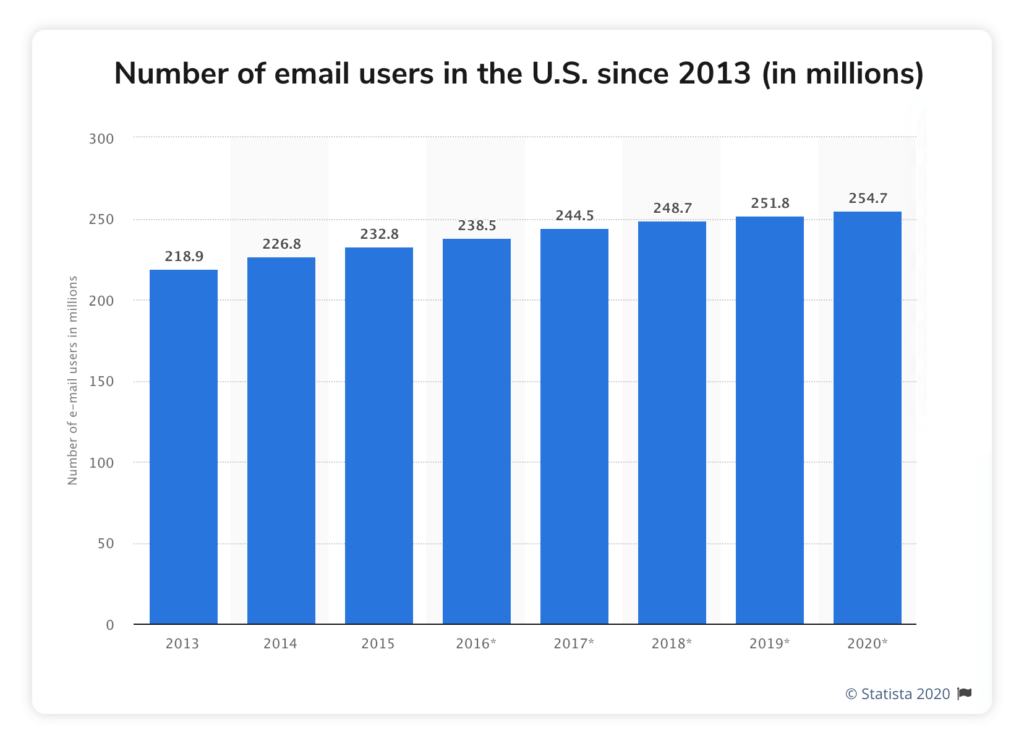
The Secrets of Successful Holiday Email Campaigns
Research that confirms the fundamentals of successful email marketing provides a rare glimpse into the exact frequency and open rates of holiday email campaigns.
Email campaigns are instrumental in two-thirds of all sales made online.
That’s one of the conclusions reached in a study by Experian Data Quality and eDataSource.
The “Unwrapping Holiday Email Success” analysis tracked email activity by five ecommerce brands: Walmart, Amazon, Zappos, Chubbies Shorts, and Staples through the holiday shopping season, from Black Friday through New Year’s Day.
The results confirm the fundamentals of successful email marketing and provide a rare glimpse into the exact frequency and open rates of holiday email campaigns.
In this Insight, we’ll consider the primary takeaways from the study, share our perspectives, and suggest ways you can leverage the lessons learned to boost your ecommerce or lead-generation revenue – not only during the holidays, but all year long.
Email marketing by the numbers
Emails get attention.
A survey by the Adobe Campaign team survey confirmed something you may already know: Americans check their email with a consistency bordering on compulsive.
Six hours each day and more than 30 hours per week – that’s an average of how much time the white collar workers in the Adobe study devote to email.
Look at your own email habits. Is email integral to your daily life, both business and personal?
It’s the same for the people you do business with. Email is one of the best ways of communicating with your customers. And the better you do at coaxing your audience to open the emails in your campaigns and act on the content you send them, the happier you’ll be with the conversion rate your emails produce.
Here’s a short list of pertinent statistics we uncovered while conducting the research for this article:
- 58% of American adults check their email first thing in the morning
- Email subscribers who get a “welcome email” are 33% more likely to engage with the brand
- Personalization improves CTR by 14% and conversion rates by 10%
- 41% of marketers say email is their primary source of analytics data
- Email drove more Black Friday conversions in 2015 than any other source
- Email with a personalized subject line gets 26% more opens
The Statista email user chart (see below) is based on information from eMarketer and Squarespace. It puts the current number of U.S. email users at 238.5 million and growing.

Basics of the email campaigns studied
One focus of the Experian/eDataSource study was to evaluate the effectiveness of list segmentation. To do that, they compared differences between campaigns that included 100K to 900K sends and campaigns with 1-5 million sends.
Deliverability
The next division grouped the campaigns by how successfully the emails were delivered. Deliverability is an indicator of list health and of how much effort the list administrator is putting into keeping it clean. The dividing line, for Adobe, was set at 90%. Failing to deliver more than 10% of the sends sent a signal of quality issues in the mailing list.
Offers in campaigns
The study also collected data on the offers presented in the campaigns. Surprisingly, perhaps, 10% of the holiday sends didn’t include an offer at all. Of those that did, price adjustments were the strategy of choice. During holiday frenzy buyers EXPECT bargains.
Here are the three most popular offers gleaned from the data:
- Free shipping (65%)
- Coupons and codes (40%)
- Discounts providing a percentage off regular price (59%)
Notice that many of the campaigns provided more than one discount method – typically free shipping in combination with a coupon, code, or discount percent.
Enjoying this article?
Subscribe to our newsletter, Good Question, to get insights like this sent straight to your inbox every week.
Case Study: Walmart email campaign metrics observed
Walmart’s deliverability rates led the pack. 95% of their emails pulled a deliverability rate of 90% or greater. Consistent cleaning and structuring of the email list is essential for getting the mail you send delivered to a working box.
Open (read) rates for Walmart ranged from 16 to 21%. While not spectacular, Walmart’s open rates were above average for retail and ecommerce in general.
Case Study: Amazon email campaign metrics observed
Amazon nearly quadrupled the number of campaigns sent by Walmart (5,743 to 1,288). Deliverability wasn’t as favorable, however, with just 85% of email sends achieving a 90% or better rate.
Amazon also exhibited a striking difference between open rates for below-90% deliverability sends (13%) and those with above-90% deliverability (19-22%). Researchers also observed better conversion rates from Amazon’s smaller, more targeted emails.
Case Study: Zappos email campaign metrics observed
Since Zappos is now owned by Amazon, the study theorized their low number of email campaigns (224) reflected a coattail-riding effect from the parent company’s intensive campaign numbers.
Zappos was able to deliver above 90% of the email sent in 92% of their emails. Open rates were fairly even at 15-17%.
Case Study: Chubbies Shorts email campaign metrics observed
This relatively new ecommerce site sent only 24 email campaigns during the holiday season. None of those returned a deliverability above 90%. Their average deliverability was 84%. The average open rate came in at a paltry 15%.
It may be that Chubbies needs time to cultivate their mailing list. Of course, selling summer wear during the winter can be a bit challenging too.
Case Study: Staples email campaign metrics observed
Deliverability for the 312 email campaigns sent by Staples fell below the acceptable mark 29% of the time. Their deliverability fluctuated between 83% and 89%.
Open rates for Staples varied widely within levels of 13-21%. As with Amazon, the best-performing emails were those sent to smaller, more targeted lists.
Primary takeaways from the holiday email campaign study
The Unwrapping Holiday Email Success research confirmed two things every email marketer should heed:
- Open rates for delivered emails sent to high-deliverability lists are considerably better than open rates for delivered emails sent to low-deliverability lists. The quality of your mailing list will never be better than the deliverability of that list. Careful grooming and cleaning is crucial.
- Open rates for emails sent to a smaller, segmented list outshine open rates for larger, unsegmented lists. Segmentation is a proven means of getting more opens and more conversions.
- Ecommerce stores should focus on the “season,” not just on the days. Adobe found that site visits did not drop off appreciably… even after Cyber Monday.
- Consumers want to receive your emails and your offers. Don’t worry about offending them. Worry, instead, about being forgotten by your customers because you aren’t sending sufficient emails.
- Deliverability issues hurt communications and lead to unnecessary costs. Wise email marketing managers are constantly working to keep the mailing list healthy.
- Emails were found to be an excellent means of identifying clients uniquely. Most people have their own email address, and they don’t share it with others. That is a huge positive for personalization efforts.
- Poor deliverability rates can result in many of a company’s emails being marked as spam. That can lead to millions of dollars in lost revenue.
For more light on the topic, consider the following findings from the 2016 State of Email Marketing study published by GetResponse:
- Only 58% of email marketers use any form of list segmentation
- Only 17% of email marketers are using mobile responsive email design
- 23% of email marketers say lead generation is their primary focus
- 36% say conversion rates and sales are the greatest benefits from email marketing
- The average open rate for ecommerce email campaigns was 16.78%
- The average click-through rate (CTR) for ecommerce was 3.07%
- 64% of ecommerce marketers plan to increase their email marketing budget
From our own observations working with ecommerce companies that consistently see positive results from their holiday email marketing efforts, there are two things you need to keep in mind when developing your campaigns:
- List segmentation delivers the best results. Ecommerce sites that devote even minimal effort to better email targeting consistently reap favorable ROI from those efforts.
- The more concern given to how well your content displays on mobile, the more prepared you are to cater to the rising number of consumers who are using mobile devices to place orders. The tide is shifting. You must be mobile-effective.
Focus your email marketing on the season, not just on the days
At The Good, we often work with clients who want to put most of their efforts into the one-week hay day of sales that begins the day before Thanksgiving and culminates on Giving Tuesday.
While every ecommerce business should include campaigns specially focused on that important week, don’t neglect the rest of the holiday season in your email marketing strategy.
Here is a list of holiday email marketing tactics we’ve seen successfully implemented for ecommerce and lead generation campaigns:
- Build the suspense with a series of emails leading up to recognized special events. Don’t just focus on Black Friday and Cyber Monday only, though. Small Business Saturday, Giving Tuesday, and (let’s not forget) Christmas Day can all be important to sales – especially so when you segment your mailing list.
- Create your own event. Name your own day. Your marketing potential is limited only by your creativity. Successful email marketing campaigns center on a reason for why you’re contacting the prospect. Nothing in the rule book, though, says you can’t create your own reason. You are not at the mercy of anyone’s calendar.
- Remember to leverage urgency in your email campaigns. You don’t have to rely on “While supplies last” messaging, especially during the winter holiday season. There really is a “Last day to order and still get the package in time for Christmas” cutoff for shipping. Cyber Monday really does only come once each year. Make your point and make it special.
- There’s a reason why the ecommerce stores Adobe studied relied on percentage discounts and coupons or discount codes in their email campaigns: shoppers love a bargain. You don’t have to cut all your prices to the bone, but you do need to stir up desire by including incentives. And remember to combine urgency with your discounted offers. Those digital codes should have an expiration date, and you should highlight that fact in your emails.
- Everyone loves to save, but everyone also loves to be rewarded. From free shipping above a certain order threshold to offering a gift card to those who purchase above a certain level, your customers will buy more when you show them the more they buy from you, the more rewards they can gain.
- Embedding videos in your marketing emails can increase conversion rates significantly. One study we read showed a 300% boost, but you’ll need to test to see how your mailing list responds. Use a still frame image with a clear play button over it, and set the link to take the reader to a landing page on your site with the video and a clear call-to-action.
- Get your customers and prospective customers involved in the fun. Tie your emails to social media promotions. Launch contests and invite participation. Cultivate the members of your mailing list to become brand advocates and co-creators of the content you produce. The more they feel they’re a part of your campaigns, the more active they’ll be in ordering from you.
Extend the holiday success to the rest of the year
Every strategic fundamental and every tactic we’ve talked about here can be applied to your email marketing campaigns all year long.
You can substitute Valentine’s Day for Black Friday or Mother’s Day for Cyber Monday. Yes, the focus is different, but the principles are the same.
Our clients know email marketing campaigns are a pillar in their overall marketing strategy. They also know there’s much that can be done to keep improving the returns from those campaigns.
Keep mailing and keep testing. Always be learning.
Enjoying this article?
Subscribe to our newsletter, Good Question, to get insights like this sent straight to your inbox every week.

About the Author
Jon MacDonald
Jon MacDonald is founder and President of The Good, a digital experience optimization firm that has achieved results for some of the largest companies including Adobe, Nike, Xerox, Verizon, Intel and more. Jon regularly contributes to publications like Entrepreneur and Inc.